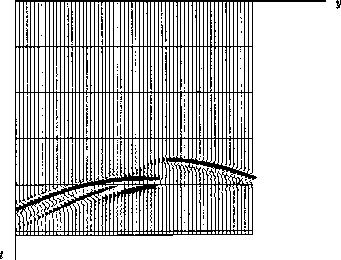




Next: Misuse of v(x) for
Up: LATERAL VELOCITY IN BIGGER
Previous: Wavefront healing
Across a single vertical fault in the earth the velocity will be a simple
step function of the horizontal coordinate.
Rays traveling across such a fault suffer
in amplitude because of
reflection and transmission
coefficients, depending on the angle.
Since near-vertical rays are common, only small velocity contrasts
are required to generate strong internal reflections.
By this reasoning, steep faults should be more distorted,
and hence more recognizable, on
small-offset sections than on wide-offset sections
or stacks.
This phenomenon is somewhat more confusing when seen in (x,t)-space.
Figure 24 was computed by Kjartansson
and used in a quiz.
Study this figure and answer the questions in the caption.
Here is a hint:
A reflected ray beyond critical angle undergoes a phase shift.
This will turn a pulse into a doublet that
might easily be mistaken for two rays.
Figure 24 exhibits a geometry
in which the exploding-reflector model
fails to produce all the rays seen on a zero-offset section.
veljump
Figure 24
Synthetic data from an exploding-reflector calculation
for an earth model containing a point scatterer
and a velocity jump v1 / v2 = 1.2 across a vertical contact.
(Kjartansson)
(a) Is the point scatterer in the slow or the fast medium?
(b) Identify four arrivals and diagram their raypaths.
(c) Identify and explain two kinds of computational artifacts.
(d) Find an evanescent wave.
(e) Find phase shift on a beyond-critical-angle reflection.
(f) A zero-offset section has ray not shown above. Where?

The exploding-reflector model produces two types of rays:
the ray that goes directly to the surface,
and the ray that reflects from the fault plane
before going to the surface.
A zero-offset section has three rays:
the two rays just mentioned, but moving at
double travel time, once up, once down;
and in addition the ray not present in Figure 24,
which hits the fault plane going one way
but not the other way.
There is a simple way to make constant-offset sections in laterally
variable media when the reflector is just a point.
The exploding-reflector seismogram recorded at x=s is
simply time convolved with the one recorded at x=g.
Convolution causes the travel times to add.
Even the non-exploding-reflector rays are generated.
Too bad this technique doesn't work for reflector models
that are more complicated than a simple reflecting point.





Next: Misuse of v(x) for
Up: LATERAL VELOCITY IN BIGGER
Previous: Wavefront healing
Stanford Exploration Project
10/31/1997
